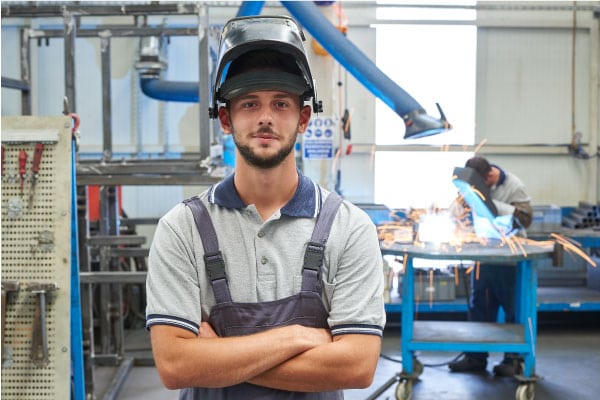What People Who Work With Their Hands Have In Common

Industrial Trades Pros Launch Press Release
March 21, 2018
Utah’s Davis Tech Offers Rocket Fuel For Your Trades Career
May 22, 2018Chances are, if you work with your hands, you share a lot in common with other people who do too. New research has begun to unlock the relationship between genetics, environment and the type of learners we all are: kinesthetic, visual, or auditory.
Kinesthetic learners are those who learn most effectively by working on physical activities. They are also called “do-ers” and reflect the type of brain “wiring” that is common in industrial tradesmen and tradeswomen (e.g. machinists, mechanics, fabricators, electricians, assemblers, welders, etc.) and other people that work professionally with their hands (e.g. artists, sculptors, carpenters, etc.).
While it sometimes feels like the whole world is shifting towards office jobs, it’s important to acknowledge this unique class of people. They not only have remarkable natural abilities that many others do not possess, but they also have the self-awareness to work in careers that leverage those abilities.
What do these people have in common? Here are a few things:
- Enhanced Dexterity and Hand-Eye Coordination
- Increased Confidence and Satisfaction
- Better Health
- A Preference For Non-Traditional Learning & Work Environments
- Solid Job Opportunities
Let’s take a look at each of these areas and explore what connects those people who work with their hands.
Enhanced Dexterity and Hand-Eye Coordination
People with the natural ability to work well with their hands tend to possess exceptional fine motor skills, which is the coordination of small muscles – usually in the hands and fingers – with the eyes to achieve precise movements. These skills are what enabled homo sapiens thousands of years ago to dominate the natural world and included the crafting of stone tools and the predictable creation of fire.
Generally, this dexterity and hand-eye coordination can be detected in children at an early age. They may appear in the form of the superior manipulation of objects, utensils, and tools or the ability to draw pictures, letters, or numbers more accurately and earlier than other children.
Children with superior dexterity and hand-eye coordination often advance quickly in art, block construction, and sports. In fact, the ability to hit a ball with a bat or racket is a skillful act of coordination in the body between the muscles, eyes and brain. A highly coordinated child will have a significant advantage in these fields compared to his or her less coordinated peers.
Increased Confidence and Satisfaction
People who work with their hands regularly report a greater sense of pride in workmanship and well-being. There is strength and power in an individual who has found a career path that aligns with his or her natural learning style and “wiring.” In addition, in most fields where people are working with their hands, at the end of the day, there is a physical product that they can hold and touch that has resulted from their work. The ability to “behold the fruits of labor” is a unique characteristic of hands-on work and is largely missing for people who work in an office.
If you work with your hands in your job, chances are you like to explore similar interests at home or in your hobbies. After all, many skills in the workplace can come in pretty handy for non-work applications. A metal fabricator or machinist may create parts for a project in his or her home workshop. A mechanic may work on a vintage car in his or her free time. These activities are well-aligned with a hands-on worker’s interests and can add an additional sense of accomplishment and satisfaction to their lives.
Better Health
Get up off your chair and start moving! That’s exactly what people who work in hands-on professions get to do every day, while others slouch at their desks. Shockingly, 80% of the workforce currently works in sedentary positions (or jobs that only require minimum amount of activity). A trend towards more sedentary work has coincided with the increasing rate of obesity in the United States according to findings from the peer-reviewed scientific journal PLOS One.
Because they are more likely to feel rewarded by physical activity in general, kinesthetic learners often engage in physical activity outside of work, whether it’s hiking, working out at the gym, or fixing up the house or garden. These additional physical activities can have a significant health benefit.
One obvious area of warning is that people who work with their hands need to look out for their health lest their financial livelihood be threatened. Being able to perform physically is essential for these people to do their job and earn their income. Remember that lifting heavy equipment or tools throughout the day can build strength, but it can also seriously hurt someone if he or she does not use proper technique.
A Preference for Non-Traditional Learning & Work Environments
As we have discussed, it is important for people who naturally enjoy physical work and learn through doing physical activities to put themselves in environments that nurture those tendencies. That said, from a learning standpoint, all children are expected to go to school and most professions include some form of classroom education. Kinesthetic learners may likely become frustrated or bored in these more traditional learning environments.
If you find yourself in these situations, it is helpful to think about the opportunities awaiting you to do the kind of work you really love. Try to remain patient. Some people never get the chance that lies ahead for you. Second, it may be helpful to speak to your teacher or instructor about your learning style and see if there may be chances to do more hands-on work as part of your coursework. Lastly, it may be possible to select schools, programs and jobs that cater to kinesthetic learners and provide educational and training experiences that are customized for hands-on learners.
For work environments, kinesthetic learners and hands-on workers are often happiest and most successful selecting employers and career paths that allow them to be outside an office environment. This doesn’t necessarily mean being on your feet all day or out in the cold. Many individuals work in a shop or studio setting where they have their own comfortable space to perform their craft, trade or service.
Solid Job Opportunities
Deloitte Consulting predicts that in the coming decade 3.5 million positions will need to be filled in manufacturing in the United States and 2 million of those jobs will go unfilled. That’s a staggering figure and represents an enormous opportunity for people who like to work with their hands to find high-demand and high-paying jobs. The path into a trades career varies based on the field, but identifying shop or trades opportunities in high school and applying to trade or applied technology schools in your area is a great first step. With high pay levels and constant demand for machinists, mechanics, fabricators, welders, electricians or HVAC technicians, people who like to work with their hands are likely to incur very little debt or expense in attaining their professional training. They are also likely to have solid job security for the rest of their careers.
These fields represent a pretty great career opportunity and you may get to be one of the lucky people who doesn’t have to work in an office!
* * *
About Xemplar Workforce Solutions
Xemplar Workforce Solutions is a premier specialty recruiting company that provides nationwide recruiting services to top professionals and the high-quality employers that value them. If you are a skilled tradesman or tradeswoman with experience in your field, contact us today to learn more about our services and see how your own recruiting specialist can help you optimize your hands-on career. Learn more about Xemplar here.




